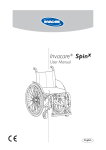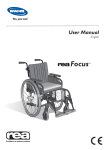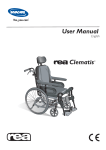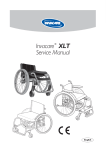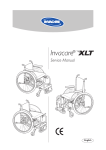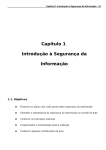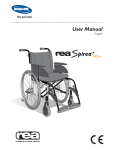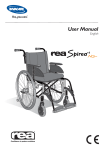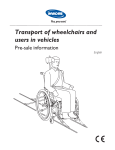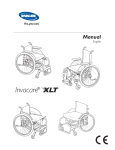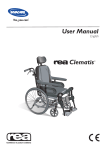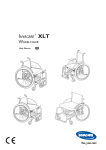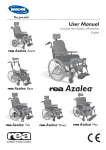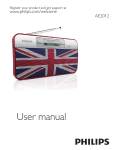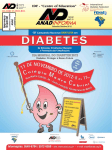Download Spirea2 - Invacare Rea
Transcript
User Manual
English
Spirea2
R
©Invacare Rea AB
Every effort has been made to ensure that the contents
of this publication are updated at the time of printing. As
part of the ongoing improvement of the products, Invacare
Rea AB reserves the right to modify existing models at any
time.
Any use of this publication, or parts thereof, as well as any
reproduction of images, must have the written consent of
Invacare Rea AB
Spirea2
R
2
Contents
Product description – Rea® Spirea2
NB!
Delivery check
Daily performance check
Parts of the wheelchair
Lifting the wheelchair
Upholstery and frame colours
Accessories and instructions
Technical data
Intended use
Safety instructions/propelling techniques
Transport
Assembly
Settings
Legrests
Footplates/Calf pads
Seat
Backrest
Armrests
Rear wheels, adjustment
Castor wheels, adjustment
Wheelchair heights
Brakes
Carer-operated brake
Push handles
Anti-tip devices
Transport of wheelchairs in vehicles
Observations
Restraint methods
Installation of pelvic belt attachment
Maintenance
Accessories
Amputee legrest
Tension adjustable backrest
Spirea2
3
3
4
4
5
5
6
6
7
7
8–9
10
11–12
13–24
13
14
14
15
15
16–19
19
20–21
22
22
23
23
24
25
26
27
28–29
30
30
30
R
3
Product description
Rea® Spirea2
Rea® Spirea2 is a wheelchair with many adjustment options
and accessories. To ensure that you benefit as much as
possible from Rea® Spirea2 , and in order to do its options
justice, the chair must be tested and adjusted by competent
personnel. We hope that you have also received instructions for using your Rea® Spirea2 in everyday life.
The Rea® Spirea2 frame, legrests and hand rims are manufactured from high quality aluminium.
Vulnerable parts, the telescopic backrest tubes and the
inner part of the legrest tubes, are made from steel.
The seat is made of either vinyl or plush and is easily
cleaned. The cushion and backrest are made of either
polyester or plush.
This manual includes a description of the parts of the chair,
simple adjustment options, how to use the Rea® Spirea2
safely and how to transport it. The manual must be read
thoroughly before the chair is used.
Also included in this manual is a description of how the
most common accessories are fitted and slightly more
advanced settings.
As the Rea® Spirea2 has many different components and
accessories, the appearance of the accessories you have
for your chair may differ from those shown.
NB!
This symbol means warning.
On the next page a number of points affecting your personal
safety are shown. Read it carefully!
Invacare® is only responsible for product changes carried
out by personnel who we authorise. We reserve the right to
make any changes to equipment and specifications without
prior notice.
Spirea2
R
4
Failure to comply with instructions given may result in personal
injury and/or product damage.
that all parts are attached securely to the frame
that all wheels and knobs are properly tightened
that all brakes and anti-tip devices function correctly
rests, backbrace or by the adjustable push handles.
chair.
the chair, because of the risk of tipping.
tipping over.
cause injury to your hands.
"#$
% $
brake is reduced in wet and slippery conditions, as well as
when on a slope.
& attached.
'
in the chair.
()
the greater the risk of tipping the wheelchair becomes.
Surfaces of the wheelchair like frame parts or upholstery,
with long time sun shining on them, can reach temperature
> 41 degrees C.
Delivery check
Check that all components comply with the delivery note.
Any damage incurred during transport should be reported
immediately to the delivery company. Retain all packaging
until the transport company has inspected the consignment
and an agreement has been reached.
Daily performance check
Check that the following parts are still currently assembled
*
&
$
+
8
Spirea2
R
5
Parts of the wheelchair
4
3
12
3
13
5
7
2
14
6
10
11
14
1
8
2
9
1.
2.
3.
4.
5.
6.
7.
8.
9.
10.
11.
12.
13.
14.
Frame (chassis)
Cross members
Backrest
Push handles
Seat
Rear wheel bracket
Rear wheel
Handrims
Brakes
Castors
Step tube/Anti tip device
Armrests
Sideguards
Legrests
LIFTING THE WHEELCHAIR
Always lift the wheelchair by gripping
the frame at the points shown in the
diagram. Never lift the wheelchair by
the removable armrests or the footrests. Ensure that the backrest and push
handles are securely in place. Also read
the chapter Safety instructions/Propelling techniques.
Spirea2
R
6
Upholstery and frame colours
Upholstery
Black Jemima TR18
Grey Plush TR32
Frame colours
Pearl Grey
Accessories and instructions
Rea® Spirea2 has a wide range of accessories and options.
Spirea2
Backrest
Slingtype
Tension adjustable
Backrest bar
Seat
Sling seat depth adjustable 5 cm
Tension adjustable and depth adjustable 5 cm
Seat cushions
5 cm
Legrests
80º legrests
Legrests (angle-adjustable)
Plaster legrest
Amputee legrest
Fixed footplate
Angle-adjustable and depth-adjustable foot plate
Heel strap
Armrests
Flip-up armrests
Height adjustable armrest
Hemiplegic armrest
Autolock for armrests
Long pad
Short pad
Castors
125-200 mm, pneumatic or solid, wide or narrow
Rear wheels
16", 22", 24", pneumatic or puncture-proof
Brake
Carer-operated
"$
Extended brake arm
Others
Several types of hand rim
Spoke guard
Anti-tip devices
Reflectors Kit
Table Tray
Pump
Cane holder
Tool kit
Push handles brace external and high adjustable
Pelvic belt
R
7
Technical data
38, 40.5, 43, 45.5,
50.5 cm
40, 45 (-5) cm
38–50.5 cm
38–46 cm
19–29 cm
327–520 cm
0°– 6°
10°
Seat width + 22 cm
76–96.5 cm
90–115 cm
29 cm
15.3 kg
max 125 kg
Transport weight
8.5 kg
Crash test*
*Our wheelchairs comply with ISO norm 7176-19 and have been tested in a basic configuration. The use in other configurations has not
been tested. See section "Test report from dynamic safety restraint test", for test configuration. Wheelchair users should however transfer
to the vehicle seat and use the vehicle installed restraint system whenever it is feasible.
Intended use
%® Spirea2 is a manual wheelchair for those using their chair active over longer periods of time (several
hours in a row) or for short time and transportation purposes.
%® Spirea2 is intended for users able to propel their wheelchair themselves but also for assistant to
push the chair.
%® Spirea2 has features and options to have the user properly and comfortable seated for many hours
per day.
'
@
MQUXYUZZ[%® Spirea2 can be used indoors and outdoors.
We recommend the use of the big castors for running on bumpy ground.
%® Spirea2
\]
^"
devices (and common sense)!
%® Spirea2 is designed to use in a combination with a seat cushion placed on the seat, without the use
of seat cushion, there is a risk of pressure sore.
%® Spirea2 should always be equipped with footrests/legrests if the wheelchair is not propelled by the
feet and have a low seat height.
Spirea2
R
8
Safety instructions/
propelling techniques
We recommend that the qualified person who has prescribed your wheelchair for you, tests the wheelchair and
that he/she makes the adjustments that you want, taking your build and needs into account. We also hope that
you have received help in learning how best to use your chair. Start by practising carefully until you are familiar
(
^
Moving to and from the wheelchair
Propel the wheelchair as near as possible to the seat that you want to
move to. Apply the brake. Remove/flip up the armrests and detach the
legrests/move them outwards. Do not put any of your weight on the
foot plates, as the chair may tip forwards.
When transfering from Rea® Spirea 2 do not place your fingers
between frame tube and seat tube.
Stretching and bending
Propel the wheelchair as near as possible. When stretching and bending, do always have full contact between the backrest and the back
otherwise the wheelchair may tip over. Stretching behind the back is
not recommended.
Propelling up a slope
Many experienced users manage to propel up a slope by themselves. In
order not to lose control of the steering and to avoid tipping backwards,
you should always lean forwards whilst propelling up a slope. Propel
the wheelchair forwards using short, quick strokes applied to the hand
rims, in order to maintain speed and steering control.
Generally, help is needed in the case of steep slopes.
If you have to stop on a slope, it is particularly important to ensure that
you do not make any sudden or unexpected backward movements when
you start moving the wheelchair forwards again. As the wheelchair is
already leaning backwards, such a movement can cause the wheelchair
to tip backwards.
Be careful not to trap your fingers between brakepin and tyre.
Propelling down a slope
We recommend that you get the help of one or more assistants when
going down steep and wet slopes.
First check the slope to see if there are any particular risks, such as
potholes, slippery sections, etc. Never use your brake to slow down.
When you apply the brake on a downward slope, the wheels lock and
the wheelchair can suddenly pull to one side, tip sideways or stop
immediately, which can cause you to be thrown out of the chair. Always
control the speed with the hand rims. Remember that the hand rims may
become hot due to friction, and this may cause injury to your hands. Try
to propel down the slope in a straight line as much as possible. Never
change direction when propelling down a slope. Never propel up or
down a slope crosswise.
Spirea2
R
9
Onto a kerb
This method is for when the assistant is always behind the wheelchair
and creates the greatest safety for the user.
Illustration 1
z $ ^ { ( securely on the footrests and cannot slide off. Then lean the wheelchair
backwards and push it forwards against the kerb.
Illustration 2
Lower the frontal part of the wheelchair onto the pavement and place
yourself as close to the chair as possible, before you lift up the whole
wheelchair.
Illustration 3
Lean forward and lift/roll the wheelchair over the pavement edge.
Illustration 4
Lower the wheelchair onto the pavement so that the weight is divided on
all four wheels. Ensure that the wheelchair does not roll backwards.
Off a kerb
Follow the procedure above, but in reverse order (step 4, 3, 2 and then
1) to move off a kerb.
Kerbs – alternative method
Generally this method is used by experienced assistants who are stronger
than average. The method can also be used when the kerb or step is
low and only constitutes a minimal obstacle.
The assistant goes backwards onto the pavement and then pulls the
wheelchair up onto the pavement. It is important for the assistant to use
his/her body correctly to prevent injury. Tip the wheelchair backwards
and roll the chair over the kerb onto the pavement. Take particular
care if the kerb is wet or slippery.
Escalators
Do not use the escalator when you are in the wheelchair. Find out
whether there is a lift nearby.
Stairs
We advise you to avoid going up/down stairs in your wheelchair where
possible, and to choose an alternative route instead.
We recommend that you receive help from two assistants to get up and
down stairs. One assistant goes in front of the chair and hold the frame
of the wheelchair, whilst the other assistant goes behind the chair and
holds the push handles. Fold the anti-tip device upwards. Balance the
wheelchair on the drive wheels until the balance point is found. The
wheelchair is then rolled down the stairs, step by step, by letting the
drive wheels roll over the edge of each step. Assistants must remember
not to hold removable armrests or legrests. In addition, assistants should
remember to lift correctly, using their legs and keeping their backs as
straight as possible.
Spirea2
R
10
Transport
When you are to transport the Rea® Spirea2 you can easily remove certain parts to make the chair smaller and
lighter.
1.
1. Start by removing the armrests.
Flip up armrests
Press the button (A), swing up the armrest.
Lift it straight up (you may need to hold it slightly
forward then lift it straight up) (B).
A
B
Detachable armrests
When having detachable one´s, just lift them up.
2a. Remove the footrests by pressing the level (B),
whilst turning the footrests outwards or inwards
and pull them straight up.
2a.
Be careful not to trap your fingers between
frame and footrest.
B
2b. Remove the legrests by pressing the level (C)
backwards, whilst turning the legrests outwards
and pull them straight up.
2b.
C
Be carefull not to trap your fingers between
frame and legrest.
Concerning the brake
The lever of the brake where the handle is located,
have a free play. The lever folds up automatically
when the legrest have been swinged to its outward
position without activating the brake. To activate
the brake just press respectively pull at its most
forward respectively rear located position.
3.
3. +
|"|^
of the sides of the seat and fold the chair completely.
If you have a backrest bar release it first by pressing
on the small nob on the inside of the tube. It will
automaticlly fall down to the side.
4.
4. Remove the rearwheels by pressing the buttom
in the centre of the hub whilst pulling the wheel
away from the wheelchair. Finally, fold the anti-tip
devices upwards (see page 23).
Spirea2
R
11
Assembly
1.
1. Attach the rear wheels by pressing the button in
the centre of the hub whilst simultaneously sliding
the axle into the rear wheel position attachment
of the positioning plate.
It is very important that you check that the
locking pin has actually locked the wheel into
position when the centre button has been
released. Take hold of the wheels and try to
detach them. This should NOT be possible.
2.
2. "
^
Be careful not to trap your fingers between
seat and frame tube.
If you have a backrest bar fold it up by just fold it
up into position see page 30 for picture.
3.
3. Insert the armrest by fitting it into the attachment
on the backrest frame and then swing it down until
it fits into position.
Do not place any fingers on the seat frame.
When having detachable armrests, just press
them down in the reciver.
4a.
4. Footrests/legrests
The wheelchair can be equipped with either footrests or legrests.
4a. Footrests
Attach the footrests by pushing the tube at the
upper part of the footrests down into the tubes
on the wheelchair. You must angle the footrests
outwards when inserting them.
Lock the footrests by turning them inwards. The
footrests are automatically locked so there is no
risk of them coming off the wheelchair.
Be careful not to trap your fingers between
frame and footrest.
Spirea2
R
12
4b.
A
4b. Legrests
Attach the legrests by pushing the tube at the
upper part of the legrests down into the tubes
on the wheelchair. You must angle the legrests
outwards when inserting them.
Lock the legrests by turning them inwards. The
legrests are automatically locked so there is no
risk of them coming off the wheelchair. The legrest
angle is adjusted by the knob (A).
Be careful not to trap your fingers between
frame and legrest.
Concerning the brake
The lever of the brake where the handle is located,
have a free play. The lever folds up automatically
when the legrest have been swinged to its outward
position without activating the brake. To activate
the brake just press respectively pull at its most
forward respectively rear located position.
Spirea2
R
13
Settings
ANGLE ADJUSTABLE LEGRESTS
Angle adjustable legrests support the legs and reduce
pressure. The legrests can be used for bandaged legs,
but not for legs in plaster casts. The legrests must
always be fitted with calf pads, footplates and heel
straps.
It is important to adjust the height and angle of the
legrests to obtain a good seating position.
1.
1.
1. Height adjustment
Loosen screw (A) with an Allen key. Adjust the
legrest into a suitable height and the screw is
caught by one of the recesses on the legrest tube.
Then retighten the screw.
2.
2. Angle adjustment
Pull the lever (B) with one hand while supporting the legrest with your other hand. When a
suitable angle is obtained, let go of the lever and
the legrest will look into one of seven preset
positions (C).
A
X~
2.
B
Do not place anything heavy, or let children
sit on the legrest. It may cause damage to the
mechanism.
C
The distance between the lowest part of
the footrest and the ground must be at least
40 mm.
FIXED LEGRESTS
Height adjustment
Loosen screw (A) with an Allen key. Adjust the
legrest into a suitable height and the screw is caught
by one of the recesses on the legrest tube. Then
retighten the screw.
C
NOTE! Don't touch the upper screw (C).
The distance between the lowest part of the
footrest and the ground must be at least
40 mm.
A
X~
Spirea2
R
14
FOOTPLATES/CALF PADS
1. Angle-adjustable footplates
Adjust the angle and the depth by loosening the
screw (A) at the footplate attachment with a 5
mm Allen key. Adjust the footplate to the correct
position and retighten the screw.
1.
A
Do not place anything on the footplate when
the screw is loose.
X~
C
2.
D
B
2. Calf pads
The calf pads can be fitted in four different depth
^
^"
(B) using an Allen key. Remove the large nut (C) on
the reverse side and place it in the other attachment hole. Move the calf pad to the new position
and secure it into place with the screw.
The height of the calf pads can easily be adjusted
using the handwheel (D).
X~
SEAT
1. Adjusting the seat depth
Fold the seat slightly. Lift up the rear part. Pull into
required depth.
1.
2. Adjustment of seat with variable shape
+ ( z )
^ " straps to adjust the shape of the seat. Always have
a cushion on the seat when testing its adjusted
shape.
2.
Spirea2
R
15
BACKREST
1.
Adjusting the backrest height
1. "
(A) at the bottom of the backcloth. Then, fold
the chair slightly, by lifting the seat upwards.
A
2. Loosen screws (B) on the back of the backpipe
with an Allen key. It is now possible to lower and
raise the back.
2.
B
X^
ARMRESTS
Adjust the height of the armrests
1.
1. Flip up armrest
If your chair is equipped with armrests that can be
raised or lowered, this is achieved by loosening the
screw (A), moving the armrest into the required
position and retightening the screw.
A
X^
2.
X^
3. Height adjustable armrest
Adjust the height of the armrests by turning the
knob or Allen key screw (C), setting the required
height and then re-tightening the knob/screw.
B
3.
C
2. Detachable armrest
If your chair is equipped with armrests that can
be raised or lowered, this is achieved by pulling
up the armrest and loosening the screw (B) under
the armrest. Move the screw up or down to the
desired position and retighten the screw. Lower
the armrest again.
D
Depth
You can also adjust the depth of the armrest pad.
Loosen the knob (D), set the pad in the required
position and re-tighten the knob.
When adjusting the height, do not put your
fingers between armrest pad and side plate as
they may get trapped.
Spirea2
R
16
REAR WHEELS, ADJUSTMENT
1.
A
B
QZ#
24 mm fixed spanner
1. Changing the balance
The rear wheel plate can be fitted in front of or
behind the frame tube. If you place the wheels in
any of the frontal positions, this will make the chair
easier to propel, but also more unstable. You can
counteract this by fitting an anti-tip device to the
chair, giving you a chair that is both easy to propel
and stable. Loosen the two attachment screws (A)
so that the attachment can be moved. To achieve
the lowest or highest seat height, you must turn
the plate upside down (B).
The tip risk increases if the rear wheel are
located in front of the backrest.
2.
2. Changing the height of the drive wheel
attachment.
The illustrations show quick-release rear wheels,
but the procedure is the same for fixed hubs.
Loosen the axle housing with a fixed key. Remove
the casing and place in a different position. For
different positions, see page 17.
When you have fitted the wheels in the correct
position, it is important that you check thoroughly that the nuts and screws are tightened
securely. The axle housing should be tightened
with a manual and dynamometric wrench calibrated to 40Nm. This is important for your
own safety!
QZ#
24 mm fixed spanner
REAR WHEEL SETTINGS – CARER-OPERATED BRAKES
1.
1. Loosen both screws (A) and remove the brake
handle.
A
Spirea2
R
17
2.
2. Remove the rear wheel by pressing button (B) on
the wheel hub and pulling the rear wheel straight
outwards.
B
3.
3. Loosen the nut (C) slightly, turn it anti-clockwise
about ½ a turn.
C
4.
4. Remove the screw and the two screw casings (D).
D
5.
E
5. Remove the brake unit (E) from the rear wheel
attachment by turning it anti-clockwise.
Spirea2
R
18
6.
6. Remove the nut (F) from its groove in the rear
wheel attachment and place it in the new position.
F
7.
7. The rear wheel attachment can be placed in two
different positions (see picture). If the brake unit is
to be placed in the lower position (see picture), the
screw with its two casings (D) must be placed in the
upper position (G) on the brake.
G
D
8.
8. Place the brake unit in its new position and turn the
brake clockwise to screw it into place. Make sure
that that the wire attachment (H) points upwards.
This is important because the screw with both
its casings (D) must fit into its attachment on the
brake.
H
D
Spirea2
R
19
9.
9. Tighten the nut (C) to the rear wheel attachment
(clockwise).
C
10.
A
10. Screw the brake handle securely into place using
the two screws (A).
Q#
10 mm fixed spanner
Spirea2
R
20
CASTOR WHEELS, ADJUSTMENT
1.
1. When you have found the seat height and seat
angle you are pleased with, it is important for
the chair's propelling ability to control that the
angle between the castor attachment and the
ground is 90°.
2.
A
2. Adjusting the angle
Loosen screws (A) approximately two turns.
Adjust the castor housing to the correct angle
by turning it. On the inside of the castor housing
there are ribbed marks that provide the possibility
to adjust to 0°, 3° or 6° angle. When the castor
house is parallell to the tube, the angle is 0°. Do not
forget to tighten the screws when you've reached
the desired angle.
Control that the castor housing is fastened
properly after the adjustment.
X
3.
A
3. Adjusting the height
Loosen the lower of the two screws (A) completely.
Loosen the upper screw approximately two turns.
Move the castor housing upwards.
Re-attach the lower screw, but do not tighten
completely.
Adjust the angle according to point 2 above.
Tighten both screws.
Control that the castor housing is fastened
properly after the adjustment.
0
Spirea2
R
21
WHEELCHAIR HEIGHTS
16" Rear wheel, 0º angle
46
46
2
2
2
2
1
46
46
50
1
-
140
150
2
2
3
4
1
180
200
200
22" Rear wheel
38
40,5
43
43
43
45,5
45,5
45,5
45,5
48
48
48
48
0°
3°
6°
0°
3°
6°
0°
3°
6°
0°
3°
6°
0°
3°
6°
0°
3°
6°
0°
3°
6°
0°
3°
6°
0°
3°
6°
0°
3°
6°
0°
3°
6°
0°
3°
6°
0°
3°
6°
6°
4
5
3
4
5
2
3
4
2
3
4
2
3
4
1
2
3
1
2
3
1
2
3
1
2
3
1
2
1
2
1
2
1
2
3
2
2
2
-
3
3
3
1
1
1
2
2
2
2
2
2
-
4
4
4
2
2
2
3
3
3
3
3
3
4
4
4
1
1
1
1
1
1
2
2
2
3
3
3
3
125
125
125
125
125
125
125
125
140
140
140
150
150
150
125
125
125
140
140
140
150
150
150
180
180
180
140
140
150
150
180
180
200
200
150
- Not applicable
Spirea2
R
22
24" Rear wheel
40,5
43
43
43
45,5
45,5
45,5
45,5
48
48
48
48
50,5
0°
3°
6°
0°
3°
6°
0°
3°
6°
0°
3°
6°
0°
3°
6°
0°
3°
6°
0°
3°
6°
0°
3°
6°
0°
3°
6°
0°
3°
6°
0°
3°
6°
0°
3°
6°
0°
3°
6°
4
5
3
4
5
3
4
5
3
4
5
2
3
4
2
3
4
2
3
4
2
3
4
1
2
3
1
2
3
1
2
3
1
2
3
1
1
2
3
3
3
1
1
1
1
1
1
2
2
2
-
4
4
4
2
2
2
3
3
3
3
3
3
4
4
4
1
1
1
1
1
1
2
2
2
3
3
3
2
1
1
125
125
125
125
125
140
140
140
150
150
150
125
125
125
140
140
140
150
150
150
180
180
180
140
140
140
150
150
150
180
180
180
200
200
200
200
200
200
- = Not applicable
Spirea2
R
23
BRAKES
1.
C
X
MA
A
To apply the brake to the chair, move the lever (A)
forwards. To release the brake, move the lever
backwards (towards you).
Take care not to trap your fingers between
the brake shaft and tyre.
Adjusting the brake
B
C
X
MA
B
1. Check that the tyres are inflated to the correct air
pressure (indicated on the tyre wall). Then, using
an Allen key, loosen the screw and slide the brake
to the desired position and tighten. The correct
distance between the brake shaft (B) and the tyre
is approx. 15 mm.
NB.
The brake must not be moved further than indicated in the picture (C).
X
Incorrect adjustments or use of the brake can
reduce the effectiveness of the brake.
Free play
The lever of the brake where the handle is located,
have a free play. The lever folds up automatically when
the legrest have been swung to its most outward
position without activating the brake. To activate the
brake just press respectively pull at its most forward
respectively rear located position.
The reason behind is that when the legrests is
swinged to the side it will in some positions interfere
with the brake lever.
CARER-OPERATED BRAKE
1.
1. M@ [ brake will be applied.
2.
2.
move the lock catch (A) upwards. Then release
the handle.
A
3.
3. %
the lock catch will release automatically.
Incorrect adjustments or use of the brake can
reduce the effectiveness of the brake.
Spirea2
R
24
PUSH HANDLES
Adjusting the height of the
push handles
1.
1. To raise or lower the height of the push handles
twist the knob at the same time as you move
the handles to the required height.Tighten once
correct position is achieved.
2.
2. When hole (A) is visible, just above the attachment,
the handle will be in the right "locking-position".
A
ANTI-TIP DEVICES
1-2.
A
The anti-tip device also acts as a step tube. It is height
adjustable and is easy to adjust.
1. Change the plastic plugs on both step tubes to
the ones enclosed. Push the anti-tip device onto
the tube and secure with screw (A) and nut (B).
B
2. Lift the spring loaded button and select the required height. Ensure that the anti-tip device
locks into its new position.
Never forget to fold down the anti-tip
devices.
X
10 mm fixed spanner
Spirea2
R
25
Transport of wheelchairs in vehicles
The Rea® Spirea2 $Q$QUZZQ^Rea® Spirea2 can be
used for transport in vehicles that have been specially adapted for this purpose. The wheelchair must be securely
fastened in the vehicle according to the methods described on the following pages. Remember that the best solution is always to move the user from the wheelchair into a normal car seat.
TEST REPORT FROM DYNAMIC SAFETY RESTRAINT TEST
(ISO-7176-19)
Test no:
Date:
+ZQ 2003-09-19
%&
Test no:
Date:
8ZU 2004-02-16
%&
Testing to be carried out
ISO-7176-19
Pulse specification
Wheelchair
* Invacare Rea AB
Rea® Spirea2, Rea® Spirea2 transport
Q^ 8
Safety restraint device
"
+**%8~%
"
+
%
User safety belt:
"
+**%'8~%
Test dummy
Hybrid III
* ^X
Test Configuration
&
%
Z
8#
z
Velcro adjustable in depth and shape
'
8#
UQ
QXZ#U
UZZ$Z$Q, 2004-02-16
The safety restraint devices used in this test must be approved according to ISO-10542. We have chosen
"$
^
Spirea2
R
26
TO OBSERVE BEFORE TRANSPORT OF
WHEELCHAIRS IN VEHICLES
*
installed restraint system of the vehicle whenever feasible.
^
been tested. See the manual, section "Test report from dynamic safety restraint test", for test
configuration.
# wheelchair and secured in the vehicle during transit. (i.e. table trays).
frame parts without the written consent of Invacare®.
$
the lap and diagonal and restraint (3-point belt).
&
as armrests, postural restraints, wheels, etc. (See illustration below.)
$QZXU$U
$
belt system, according to the methods described in the manual.
$ parking brake applied.
X
$Q$Q
for users up to 125 kg.
Z^
If possible, a headrest should be used during transit, in order to reduce the risk of neck unjury.
The headrest should be placed as high as possible.
Please observe that even if these products and recommendations are provided in order to
increase security and safety, injury to vehicle occupants still might occur in the event of a collision
or other accidents and no guarantee is given in this respect.
Correct placement of belt
Spirea2
Incorrect placement of belt
R
27
RESTRAINT METHODS
Rea® Spirea2
C
B
A. Frontal restraints with straps
1. Connect the frontal straps around the frontal part
of the frame.
2. Release brakes and tension front straps by pulling
the wheelchair backwards from the rear.
3. Re-apply wheelchair brakes.
B. Rear restraints
1. Attach the snap hooks in the holes on the belt
attachments.
2. Tighten the straps.
C. Fastening of seat belt and safety belt
1. Check that the seat belt on the wheelchair is correctly fastened.
2. Fasten the 3-point safety belt over the user.
If pelvic belt on the wheelchair is missing we
recommend that the user should transfer to
the seat of the vehicle, if possible.
The safety belt should not be kept from the
(
^
A
C
B
A
Spirea2
R
28
PELVIC BELT
1. The pelvic belt is used to prevent the risk of falling or
sliding out of the chair and for providing the user with
a good posture.
1.
When in use, make sure that the belt is
threaded through both plastic buckles otherwise the belt might slide and not provide the
necessary support.
2-3.
2. The pelvic belt is used to prevent the risk of falling or
sliding out of the chair and for providing the user with
a good posture.
3. Adjustment
Ensure that the user is sitting fully back in the seat
and that the pelvis is as upright and symmetrical as
possible - not forward on one side or tilted back.
Position the lap belt so that the hip bones can be
felt above the belt. Adjust the length using the
buckles so that there is just sufficient room for your
hand to slide between your body and the belt. It
is recommended that the clasp is kept in a central
position, i.e. make adjustments to each side. These
adjustments should be checked and possibly changed
each time the belt is used.
4. Installation of pelvic belt attachment
Remove nut (A) from the upper screw of the
rear wheel attachment.
Insert screw (B) from the outside of the wheelchair into the free hole on the backrest tube.
Put two plastic washers on the end of screw (A).
Fit the pelvic belt attachment (C) on the two
screws and tighten both nuts (A, D).
4.
C
D
A
B
X
10 mm Spanner
Spirea2
R
29
Maintenance
Guarantee
Rea® Spirea2 is covered by a guarantee of two years from the delivery
date.
Cleaning
*
cloth. A mild detergent may be used. If necessary, the upholstery
can be washed at 40ºC. Ordinary washing powder/liquid can be
used.
Washing and Disinfection
1. Remove all loose and removable covers and wash these in a washing machine following the washing instructions for each article.
2. Spray the wheelchair with detergent, for example a car-cleaning
agent with wax, and leave on to work.
3. Rinse the wheelchair with a high-pressure cleaning or ordinary jet
of water depending on how dirty the chair is. Do not aim the jet
towards bearings and draining holes. If the wheelchair is washed
in a machine the water must not be hotter than 60 degrees.
4. Spray the chair with alcohol for disinfection.
5. Leave the chair to dry in a drying cabinet. Remove parts where
water has collected for example in end tubes, ferrules etc. If the
chair has been washed in a machine, blow-drying with compressed
air is recommended.
Wheels and tyres
*#
oil.
+
the tyres can be pumped up using the same type of pump used
^
^X XZ
Low profile tyres 7.0 bar 90 psi
QXZ UX
When inflating the tyres there is a risk of explosion
when inflating to much
Technical servicing
(
specifications may be used.
(^
wheelchair should be checked by authorised wheelchair technicians or Invacare's service department once a year. The address
and telephone number are on the back cover of the manual.
^
damage, please contact Invacare immediately. The address and
telephone number are on the back cover of this manual.
Service life
We estimate that Rea® Spirea2 has a service life span of five years.
It is difficult to state the exact length of the service life of our products, and the length stated is an estimated average life span based on
normal use. The life span may be considerably longer if the wheelchair
is used to a limited extent, and if it is used with care, maintained and
handled properly. The life span may be shorter if the wheelchair is
subjected to extreme use.
Spirea2
R
30
Accidents/Near-accidents
Please inform your Invacare sales company (phone number is on the back
cover) of any accidents/near-accidents that were caused by this wheelchair
and that have led to/could have led to personal injury.
The relevant authority in your country must also be notified.
Testing
Rea® Spirea2 has been tested and approved by The Swedish Handicap
Institute and is CE -marked according to the Medical Device Directive.
Recycling
The wheelchair Spirea2 can be divided into the following main compo
+
"
*
+
Chassis
The chassis is produced in aluminium and is fully recyclable. Recycling
aluminium requires only 2–5 % of the energy compared to new produced
aluminium.
Plastic parts
The plastic parts in the chairs are produced of plastic of the family "Thermoplastic" and are marked with recycling symbols (where it is possible
@[^
^
can be recycled or burned in approved facilities.
Upholstery
"
+"%
+)^
way to recycle the parts is to burn them in approved facilities.
Wheels, tyres and tubes
or aluminium and can be recycled according to above.
to above.
Packing
All Invacare Rea AB packing material are developed to fit the products
in an optimal way to reduce unnecessary waste in material. All boxes
are recyclable.
Contact your local recyclling agent to get correct information how to
handle the above mentioned materials.
Surface treatment
Lacquered surfaces are lacquered with polyester. Some steel parts are
@$^
^)
parts are lacquered.
Spirea2
R
31
Accessories
AMPUTEE LEGREST
1.
A
B
1. Attach the legrests by pushing the tube at the
upper part of the legrests down into the tubes on
the wheelchair. You must angle the legrests outwards when inserting them. Lock the legrests by
turning them inwards. The legrests are automatically locked so there is no risk of them coming off
the wheelchair.
2. M[ ( z
(^
Slacken screws (B) in order to adjust the cushion
height.
Warning Tip risk
There is an increased risk of tipping for
^"$
re-balance the wheelchair when amputee
legrests are used
X
TENSION ADJUSTABLE BACKREST
Adjustment of backrest
1.
1. Detatch the left hand side of the back brace by
depressing the catch on the inside of the left hand
bracket and then rotate the brace downwards.
Fold the chair slightly by taking hold of the the
seat and pulling upwards. Then loosen and fold the
backcloth forward, so that it rests on the seat.
2. Slacken and remove the screws (A) on the rear of
the back tube, using an Allen key. It is now possible
to raise or lower the back.
2.
X
3.
A
3. Adjust the shape of the backrest by adjusting the
six Velcro straps.
The user should be seated in the chair when
adjusting the Velcro straps. When adjustment is
complete fold the backcloth back into position and
secure it with the Velcro straps.
Spirea2
R
32
4. Please observe that the backrest bar may not be
used for lifting the chair!
4.
Spirea2
R
33
Spirea2
R
34
Spirea2
R
35
Manufacturer:
Invacare Rea AB
Växjövägen 303 S-343 71 DIÖ SWEDEN
Sales Units:
Danmark:
Invacare A/S, Sdr. Ringvej 37, DK-2605 Brøndby
Tel: (45) (0)36 90 00 00, Fax: (45) (0)36 90 00 01
[email protected]
Deutschland:
Invacare Aquatec GmbH, Alemannenstraße 10,
D-88316 Isny
Tel: (49) (0)75 62 7 00 0, Fax: (49) (0)75 62 7 00 66
[email protected]
Ulrich Alber GmbH, Vor dem Weissen Stein 21,
D-72461 Albstadt-Tailfingen
Tel: (49) (0)7432 2006 0, Fax: (49) (0)7432 2006 299
[email protected]
European Distributor Organisation:
Invacare, Kleiststraße 49, D-32457 Porta Westfalica
Tel: (49) (0)57 31 754 540, Fax: (49) (0)57 31 754 541
[email protected]
España:
Invacare SA, c/Areny s/n, Polígon Industrial de Celrà,
E-17460 Celrà (Girona)
Tel: (34) (0)972 49 32 00, Fax: (34) (0)972 49 32 20
[email protected]
France:
Invacare Poirier SAS, Route de St Roch, F-37230
Fondettes
Tel: (33) (0)2 47 62 64 66, Fax: (33) (0)2 47 42 12 24
[email protected]
Ireland:
Invacare Ireland Ltd, Unit 5 Seatown Business
Campus, Seatown Road, Swords, County Dublin Ireland
Tel: (353) 1 810 7084, Fax: (353) 1 810 7085
[email protected]
Italia:
Invacare Mecc San s.r.l., Via dei Pini 62, I-36016
Thiene (VI)
Tel: (39) 0445 38 00 59, Fax: (39) 0445 38 00 34
[email protected]
Nederland:
Invacare BV, Celsiusstraat 46, NL-6716 BZ Ede
Tel: (31) (0)318 695 757, Fax: (31) (0)318 695 758
[email protected]
[email protected]
Norge:
Invacare AS, Grensesvingen 9, Postboks 6230,
Etterstad, N-0603 Oslo
Tel: (47) (0)22 57 95 00, Fax: (47) (0)22 57 95 01
[email protected]
[email protected]
Österreich:
Mobitec Mobilitätshilfen GmbH, Herzog Odilostrasse 101, A-5310 Mondsee
Tel: (43) 6232 5535 0, Fax: (43) 6232 5535 4
[email protected], austria@invacare.
com
Portugal:
Invacare Lda, Rua Estrada Velha, 949, P-4465-784
Leça do Balio
Tel: (351) (0)225 1059 46/47, Fax: (351) (0)225
1057 39
[email protected]
Sverige & Suomi:
Invacare AB, Fagerstagatan 9, S-163 91 Spånga
Tel: (46) (0)8 761 70 90, Fax: (46) (0)8 761 81 08
[email protected]
[email protected]
Switzerland:
Mobitec Rehab AG, Benkenstrasse 260, CH-4108
Witterswil
Tel: (41) (0)61 487 70 80, Fax: (41) (0)61 487 70 81
[email protected]
[email protected]
United Kingdom:
Invacare Limited, Pencoed Technology Park, Pencoed, Bridgend CF35 5HZ
Switchboard Tel: (44) (0)1656 776200, Fax: (44)
(0)1656 776201
Customer services Tel: (44) (0)1656 776222, Fax:
(44) (0)1656 776220
[email protected]
Art. No. 1431575-7 2011-08-15
Belgium & Luxemburg:
Invacare nv, Autobaan 22, B-8210 Loppem
Tel: (32) (0)50 83 10 10, Fax: (32) (0)50 83 10 11
[email protected]




































